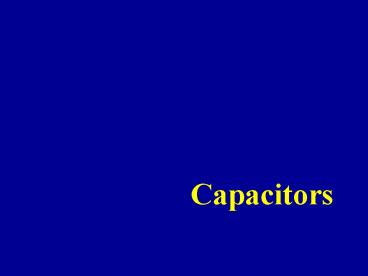Capacitors - PowerPoint PPT Presentation
1 / 34
Title:
Capacitors
Description:
Capacitor Charging. Capacitor remains charged when power source is removed ... Resistance introduces the element of time into charging and discharging a capacitor ... – PowerPoint PPT presentation
Number of Views:150
Avg rating:3.0/5.0
Title: Capacitors
1
Capacitors
2
Leyden Jar
3
Leyden Jar Battery
4
Capacitor Construction
5
Capacitors
6
Schematic of simple circuit with capacitor
7
(No Transcript)
8
Capacitor Charging
9
Capacitor Charging
Current stops when capacitor is fully charged
10
Capacitor Charging
Capacitor remains charged when power source is
removed
11
Charging Capacitor Voltage
appliedvoltage
chargevoltage
Time
12
Capacitor Discharging
Capacitor discharges when a current path is
applied
13
Capacitor Discharging
Capacitor discharges when a current path is
applied
14
Capacitor Discharging
Capacitor discharges when a current path is
applied
15
Capacitor Discharging
Capacitor discharges when a current path is
applied
16
Capacitor Discharging
Capacitor discharges when a current path is
applied
17
Capacitor Discharging
Capacitor discharges when a current path is
applied
18
Capacitor Discharging
Capacitor is fully discharged when plates are
neutral
19
Time Constant
- Resistance is unavoidable in circuits, through
the wire itself or through components such as
resistors. - Resistance introduces the element of time into
charging and discharging a capacitor - The voltage across a capacitor cannot change
instantaneously because it takes finite time to
move charge from one point to another. - The rate at which a capacitor charges or
discharges is determined by the time constant t
RC (seconds) - During one time constant interval, the charge on
a capacitor changes approx. 63 - Five time constant intervals is accepted as the
time to fully charge or discharge a capacitor and
is called the transient time.
http//murray.newcastle.edu.au
20
RC Time Constant
- Time (seconds) R (megohms) C (microfarads)
21
of charge
time
22
Charging Capacitor Voltage
appliedvoltage
chargevoltage
Time
23
Charging Capacitor Voltage
appliedvoltage
resistance added
chargevoltage
Time
24
Discharging Capacitor Voltage
appliedvoltage
chargevoltage
Time
25
Discharging Capacitor Voltage
appliedvoltage
resistance added
chargevoltage
Time
26
(No Transcript)
27
Relay Circuit
6 V
28
Relay Circuit
6 V
29
Relay Circuit
When switch button is released, relay relaxes
6 V
30
Relay Circuit w/capacitor
6 V
31
Relay Circuit w/capacitor
6 V
Relay activates
32
Relay Circuit w/capacitor
switch open
6 V
capacitor discharges through relay coil, which
maintains the magnetic field for a time
33
Relay Circuit w/capacitor
switch open
6 V
Relay remains activated for a period of time
34
Relay Circuit w/capacitor
6 V
Capacitor is discharged so relay relaxes































